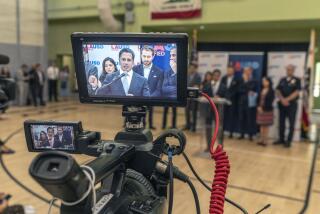A One-Year Trial Worth Trying : Two San Diego principals want to give controversial Channel One a chance
- Share via
A proposal by two San Diego secondary schools for a one-year pilot test of the controversial commercial TV news program Channel One poses a conflict between two worthy goals: protecting classrooms from the encroachment of commercialism versus decentralized decision making.
Channel One is a daily 12-minute news show with two minutes of advertising distributed free to high schools by Whittle Communications, along with television sets, VCRs and a satellite dish. The downside is that, in return, the schools must show the program, including ads, 90% of the time, subjecting students to pitches for candy bars, movies and clothing ads targeted at their age group. The schools are also held hostage. They lose the TVs and VCRs, and the considerable contribution of these devices to other educational efforts, if they turn off the set too often or if they quit the program.
For the record:
12:00 a.m. Oct. 6, 1991 For the Record
Los Angeles Times Sunday October 6, 1991 San Diego County Edition Metro Part B Page 2 Column 5 Metro Desk 1 inches; 36 words Type of Material: Correction
Channel One--A Sept. 28 editorial incorrectly identified one of the two San Diego schools that wants to experiment with the controversial TV news show Channel One. The two schools are Mira Mesa High School and Memorial Junior High School in Barrio Logan.
At a time when society is, and should be, trying to cut back on the estimated 200,000 TV commercials that children see in their first 18 years, this adds to kids’ exposure. It also accelerates the intrusion of commercialization into schools, where commercial sponsorship of sports and other activities is already heavy.
Whittle’s educational program--unlike those of CNN and Cable in the Classroom, which provide children’s news shows without ads and without free equipment--is not the ideal approach. Schools would be better off if they owned the equipment and were free to choose the best programs for each class and situation.
But these are not ideal times. The economic reality is that most schools don’t have the resources to buy as many TVs, VCRs and educational videotapes as they wish.
What’s more, if the benefits of decentralization are to be realized, some risks must be taken. Principals need the freedom to try new approaches. This seems a reasonable gamble.
Whittle is allowing a one-year trial, as opposed to its usual three-year contract. It has tentatively offered to pay any legal costs and damages the district might incur if Bill Honig, state superintendent of public instruction, takes the district to court. The news show might even raise students’ current-events IQ, and the schools would have access to dozens of video educational programs each month without commercials. Instructors could even use the commercials as a way to teach students to view television more critically.
Education leaders nationwide have been encouraging schools to take more initiative. Here is an opportunity to put that to the test. The San Diego school board should support this one-year experiment.
More to Read
Sign up for Essential California
The most important California stories and recommendations in your inbox every morning.
You may occasionally receive promotional content from the Los Angeles Times.









